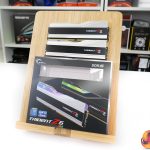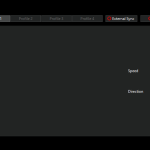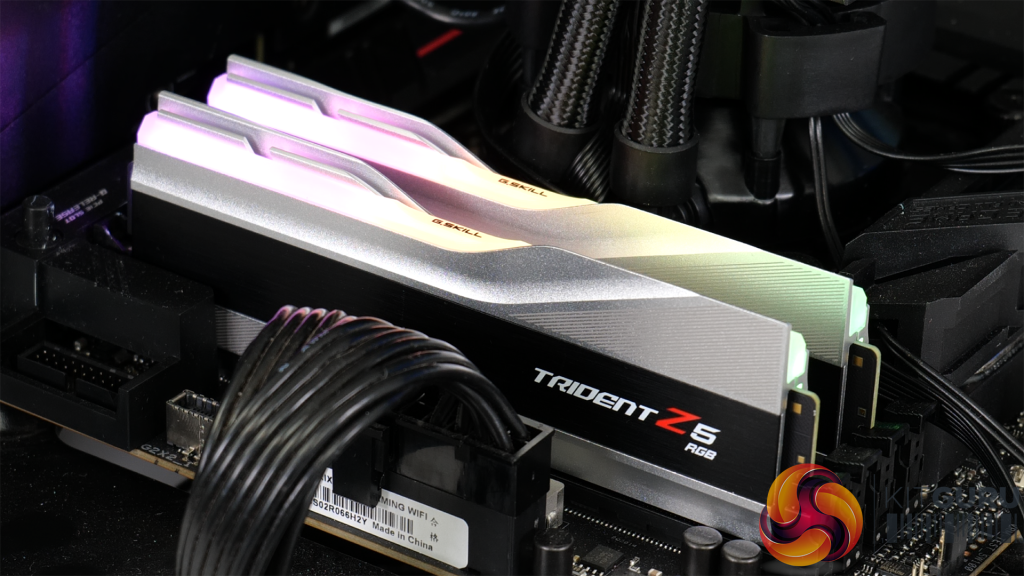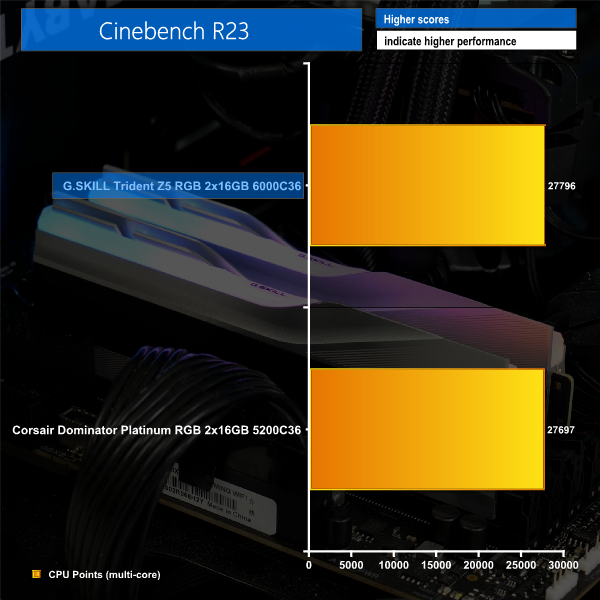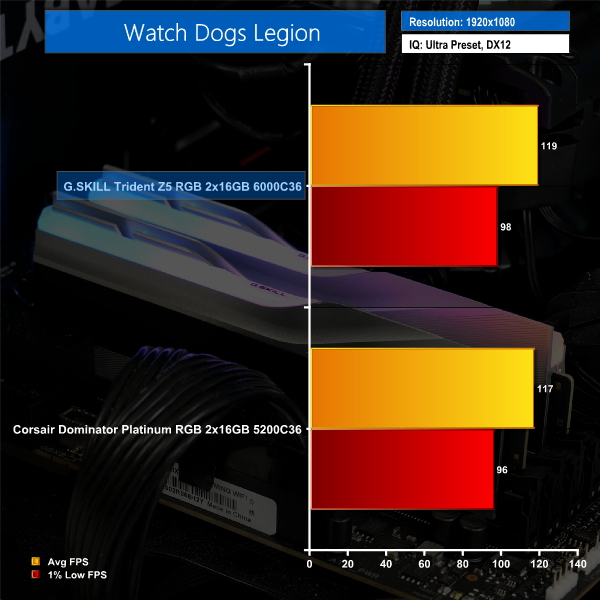
DDR5 is still relatively fresh on the scene but thankfully availability has now improved since its launch about half a year ago. With improved availability comes not only the chance to actually buy a kit, but also the ability to buy some higher-end, more boutique modules. That’s where G.SKILL’s Trident Z5 RGB 32GB set comes into play, with an impressive 6000MHz operating speed and CAS Latency of 36. 6GHz RGB DDR5 from G.SKILL – let’s take a closer look!
Timestamps
00:00 Start
00:52 Specifications
02:08 Appearance / Styling / Lighting
03:11 RGB Management
03:37 Pricing
04:20 Test system
05:16 Test results
07:22 Luke's findings / overclocking
08:18 Closing Thoughts
In terms of styling, G.SKILL has shifted the design slightly from the DDR4-era Trident Z. Now, we get a little more curved flow to the angles of the tri-fin, aluminium heatspreader instead of the sharp corners of DDR4 Trident Z.
G.SKILL sells the modules in matte black or metallic silver colour; we have the silver set which I think contrasts the black naming strip nicely.
I would describe the Trident Z5 module design as sensible, high-quality, and eye-catching. At around 45mm tall, module height is reasonable.
G.SKILL’s specs for the Trident Z5 RGB kit we have here are impressive. This is a DDR5 kit running at 6000MHz XMP 3.0 frequency, it’s a dual-channel 2x16GB 32GB set using single-rank modules, and the timings are 36-36-36-96 at 1.35V.
The set uses Samsung ICs according to CPU-Z. But unfortunately we can’t tell the exact IC model details as Thaiphoon Burner doesn’t seem to like our Z690 and DDR5 test system. You also get a thermal sensor to monitor module temperatures in software.
For reference, the actual model code of this Trident Z5 RGB kit is: F5-6000J3636F16GX2-TZ5RS.
Pricing of the 6GHz G.SKILL kit is certainly hefty at a penny under £420 in the UK. This is very expensive for a 2x16GB set of DDR5 memory. As a comparison, the 5600C36 Dominator Platinum RGB competitor is around £100-120 cheaper at £300-320.
In fact, £420 for G.SKILL’s 32GB set is close to 64GB alternative kit money. Though, granted a comparable 64GB kit of something like Corsair Dominator Platinum RGB is closer to £500 with a notable speed reduction too.
Other 6000MHz kits set you back at least £380 when looking at equivalently premium levels. So G.SKILL is still notably more expensive, but an extra 10% for one premium RAM kit versus another is likely tolerable for this market segment.
For a better look at the G.SKILL kit's RGB lighting, check out our video review.
LED lighting is handled by eight RGB zones on top of the Trident Z5 RGB modules. This light then disperses through a plastic diffuser bar for a smooth and graduated colour gradient.
I personally loved the Trident Z RGB and Trident Z Royal modules of the DDR4 era and I think G.SKILL does a superb job to make the DDR5 Trident Z RGB to look just as good, particularly with the smoothness of that LED light diffusion bar.
In terms of RGB management, G.SKILL offer their own lighting control software. It is actually reasonably comprehensive and allows individual control of the 8 LED zones. You can select a few different modes and then settings such as speed and brightness.
You will probably want to use motherboard vendor software for control and sync to match other components. That can be done through the individual tools which are: ASUS Aura Sync, Gigabyte RGB Fusion 2.0, MSI Mystic Light Sync, and ASRock Polychrome Sync.
Looking at CPU-Z, we see notation of the Samsung memory ICs used. But with the incompatibilities of Thaiphoon Burner, it is difficult to tell exactly which Samsung ICs are used.
- Model Number: F5-6000J3636F16GX2-TZ5RS
- Capacity: 32GB (2x 16GB)
- Rated Frequency: DDR5-6000MHz
- Rated Timings: 36-36-36-96
- Voltage: 1.35V XMP 3.0
We will be outlining the memory kit's performance with the Intel Core i9-12900K CPU, ASUS ROG STRIX Z690-F Gaming WiFi motherboard, and a Gigabyte RTX 3080 Eagle OC graphics card. The processor is maintained at its stock frequency.
We have updated to more recent BIOS revisions on the ASUS ROG STRIX Z690-F Gaming WiFi test motherboard. Plus, we have updated test software and Windows versions since the Z690 platform launch and our DDR4 vs DDR5 direct comparison video which you should also check out.
As such, we have clean test data from the only other DDR5 kit we have at hand – a 32GB set of Corsair Dominator Platinum 5200MHz C36 memory. This kit uses Micron ‘A’ spec ICs and retails for £320, but it is an upmarket kit from Corsair that is a reasonable contender to G.SKILL’s Trident Z5 RGB.
Test Memory Kits:
For our DDR5 comparison kits, we have a reasonable variety of frequencies, single-rank, dual-rank, and 4-DIMM single-rank kits.
- DDR5 – G.SKILL Trident Z5 RGB: 6000MHz 36-36-36-96 32GB (2x16GB Single-Rank), F5-6000J3636F16GX2-TZ5RS, 1500MHz Intel CPU Memory Controller Clock, around £420.
- DDR5 – Corsair Dominator Platinum RGB: 5200MHz 36-38-38-74 32GB (2x16GB Single-Rank), CMT32GX5M2B5200C36FE, 1300MHz Intel CPU Memory Controller Clock, around £320.
Test System:
- Processor: Intel Core i9-12900K at XMP settings
- DDR4 Motherboard: ASUS ROG STRIX Z690-F Gaming WiFi
- Graphics Card: Gigabyte RTX 3080 Eagle OC
- System Drive: Corsair MP600 1TB PCIe Gen 4 SSD
- Operating System: Windows 11 Pro
Tests:
- 7-Zip v21 – Built-in 7-Zip benchmark test (CPU & Memory)
- Cinebench R23 – All-core CPU benchmark (CPU & Memory)
- Blender 3.1.2 – All-core rendering of the Classroom benchmark (CPU & Memory)
- AIDA64 – Memory bandwidth, memory latency (Memory)
- SiSoft Sandra – Memory bandwidth (Memory)
- 3DMark TimeSpy – Time Spy (1440p) test (Gaming)
- 3DMark CPU Profile – CPU Profile test, Max Threads (Gaming)
- F1 2020 – 1920 x 1080, Ultra High quality preset, DX12 version (Gaming)
- Far Cry 6 – 1920 x 1080, Ultra quality preset, HD textures OFF, DX12
- Watch Dogs Legion – 1920 x 1080, Ultra quality preset, DX12 version (Gaming)
Memory Benchmarks
Memory bandwidth numbers are significantly higher on the G.SKILL kit thanks to its 6000MT/s operating speed. This comes as zero surprise, given that these are simply two dual-channel, single-rank kits that differ by their frequency and timings.
Latency is also a strong victory for the Samsung-based G.SKILL set thanks to its higher operating speed whilst maintaining a timings advantage. This is one of the clear indicators of a premium memory kit – the speed is bumped-up but the timings do not suffer in return.
Compute and Productivity Tests – Rendering and 7-Zip
Starting out the real-world tests with Cinebench and Blender, we see effectively no difference in the rendering performance output by either memory kit. These tests are clearly more focused on CPU – not memory – grunt, so let’s move onto the next set of data.
7-Zip shows a sizable gain for the compression workload on G.SKILL’s 6GHz Trident Z RGB set. That’ll be useful to those who deal with hefty file compressions on a frequent basis. Decompression performance, however, is practically the same on Corsair’s slower and cheaper DDR5 competitor.
3DMark Tests
3DMark’s CPU profile test shows effectively no gain for the 6000MHz Trident Z5 RGB memory. The CPU scoring section of the Time Spy test is a little faster on G.SKILL’s higher-clocked sticks, though.
Gaming Tests
Now looking at 1080p gaming, we see F1 2020 delivering a small boost in frame rates for the faster G.SKILL kit. This performance uptick is minor, particularly at such lofty frame rates already.
The 6000MHz Trident Z5 RGB set is also quicker in Far Cry 6, and this time, the performance increase may be a touch more important given the proximity to 120Hz/165Hz displays and the frame rate targets for such monitors.
Watch Dogs Legion is also a couple of FPS quicker for G.SKILL on both the average and 1% low metrics.
Gaming performance is clearly better for G.SKILL’s 6GHz Trident Z5 RGB set versus 5200C36 Dominator Platinum RGB. But whether the small differences are actually worth the extra cost is heavily debatable.
Overclocking will understandably be very much dependent upon luck of the draw with your individual kit. As such, we don’t assign too much weight to the overclocking results that we see with a sample size of one. There’s no harm in a quick tinker though.
Running at 1.35V for the default XMP configuration, we weren’t comfortable pushing voltage higher when aiming to overclock the kit. We also wanted to keep the stock timings as they’re a clear strength of the kit.
We managed to hit 6200MHz memory speed by simply adjusting the setting in our ASUS motherboard UEFI. 6400MHz would boot but was not stable.
So, a quick-and-easy speed boost up to 6.2GHz whilst maintaining the stock voltage and timings is a perfectly fine increase.
There’s a lot to like from the G.SKILL Trident Z5 RGB DDR5 kit. Out-of-the-box performance is solid in applications that will take advantage of a strong mix between 6000MHz memory frequency and tight – 36-36-36 – timings; 7-Zip file compression is the perfect example there, and gaming performance is also a little improved versus a 5200MHz C36 competitor.
With that said, the performance uplifts that we see for gaming alone are probably not worth the roughly £100-120 price increase versus an equally-premium 32GB 5200MHz kit such as Corsair’s Dominator Platinum RGB.
I guess what I am really saying here is that 6GHz memory with tight timings is expensive. And G.SKILL’s tight timings 6GHz kit is particularly expensive at £420 in the UK.
We really cannot argue with the allure of this kit though. The raw styling is excellent – G.SKILL has nailed module design for many years with the Trident Z range and the Z5 iteration continues that trend.
Plus, G.SKILL’s implementation of the RGB LED light bar really is a superb example of excellent product design. The control mechanisms through own-brand software or motherboard vendor synchronisation are positive, too.
To summarise; expensive, yes, but well-designed and high-performance; we can see how the 6GHz G.SKILL Trident Z5 RGB 32GB kit will appeal to a lot of Z690 users looking for a particularly premium set of memory.
You can buy this kit for £419.99 from CCL HERE.
Discuss on our Facebook page HERE.
Pros:
- Strong performance in workloads that can leverage 6000MHz C36 memory well
- Tight out-of-the-box XMP timings
- Superb styling
- Excellent RGB LED light implementation
- Some overclocking capacity
Cons:
- Expensive, even for the premium memory kit domain
- Improvement to gaming performance is perhaps not worth the price tag
KitGuru says: High clocks, tight latencies, and superb design – G.SKILL’s 6000C36 Trident Z5 RGB kit is very appealing, if your wallet can withstand the blow.
 KitGuru KitGuru.net – Tech News | Hardware News | Hardware Reviews | IOS | Mobile | Gaming | Graphics Cards
KitGuru KitGuru.net – Tech News | Hardware News | Hardware Reviews | IOS | Mobile | Gaming | Graphics Cards


